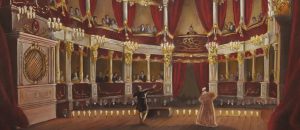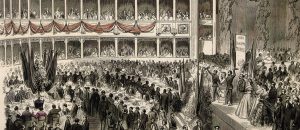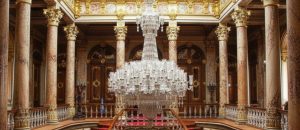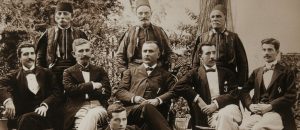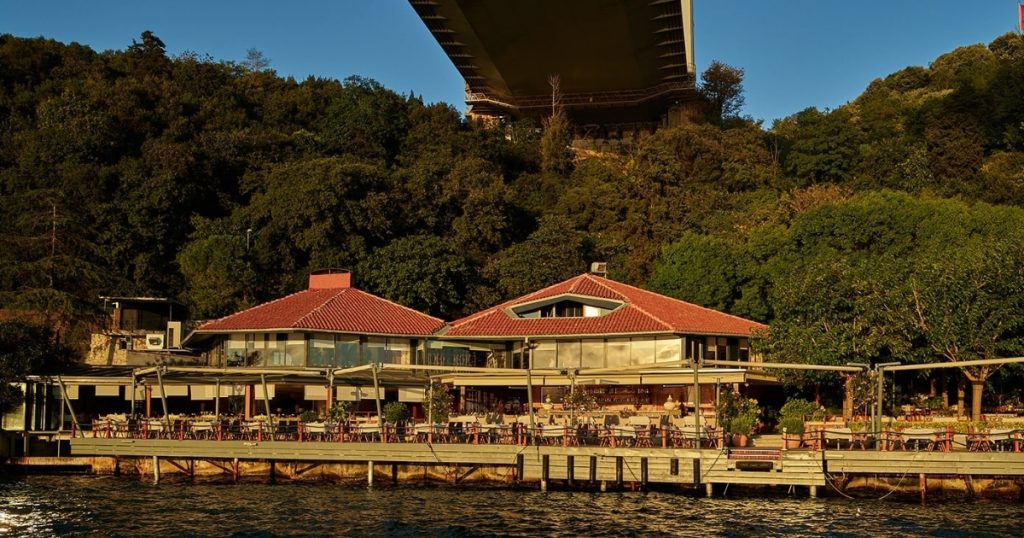The construction of Dolmabahçe Palace irrevocably transformed not only the Sultan’s living space but also the Ottoman Empire’s centuries-old, most deep-rooted, and most traditional state ceremonies. Rituals like the Cülus (accession to the throne) and Bayramlaşma (festive greetings), which were shaped around the “sini” (tray) and the “throne” in the courtyards of Topkapı Palace, inevitably took on a European “ball” or “reception” atmosphere when they began to be held in Dolmabahçe’s colossal and holistic Ceremonial Hall (Muayede Salonu). The venue itself—that is, the architecture of Dolmabahçe—became the most potent actor forcing traditional rituals to be reshaped in accordance with Western protocol. [Link: Life and culture in Dolmabahçe -> /learn/life-and-culture-in-the-palace]
Traditional Ceremony at Topkapı: Hierarchy and Distance
Traditional ceremonies at Topkapı Palace were conducted with a strict hierarchy and an understanding that placed distance between the Sultan and his subjects, consistent with the fragmented structure of the venue.
Bayramlaşma Ceremony: The Sultan, seated on the throne placed in front of the Gate of Felicity (Bâbüssaâde Kapısı, the third gate of the Palace), would receive the state dignitaries (viziers, ulema, army commanders) who individually kissed his robe edge according to their rank. This was an extremely vertical and static ritual, showcasing the Sultan’s absolute authority and the fealty of his subjects to him.
Cülus Ceremony: The New Sultan would again sit on his throne in front of Bâbüssaâde, and the state dignitaries would pledge their allegiance to him. The most important moment of the ceremony was the “cülus bonus” (accession gratuity) distributed to the Janissaries. This was also a traditional element symbolizing the negotiation of power with military strength.
These ceremonies took place in courtyards closed off to the public, with the participation of a specific elite, and in an arrangement where the Sultan was central and hardly moved.
Transformation at Dolmabahçe: The Ceremonial Hall and the Spirit of “Reception”
The Ceremonial Hall (Muayede Salonu), the single, colossal space designed for these ceremonies in Dolmabahçe Palace, changed everything. [Link: The overwhelming architecture of the Hall -> /tavanlar-sutunlar-ve-bosluklar-dolmabahcenin-ic-mekan-mirmarisi-neden-bir-guc-gosterisidir], imposed its own protocol.
Integrity of the Venue: The ceremony was no longer held in front of a gate, but inside a single, colossal, enclosed space resembling a ballroom in European palaces. This created a more horizontal and “social” atmosphere where everyone attending the ceremony could see each other.
Location of the Throne: The Sultan’s throne was placed in the middle of the hall’s Bosphorus-facing facade, in front of large windows. The Sultan was no longer turning his back to the palace walls, but was facing the world and the Bosphorus.
Changing Ritual: Instead of coming forward in a single file line to kiss the Sultan’s robe edge, as before, state dignitaries were admitted to the hall in groups according to their rank and greeted the Sultan collectively. The Sultan could also sometimes stand up and walk among his guests. This brought the ceremony closer to a more dynamic and social format of a “reception” or “palace ball,” away from a static ritual of fealty.
Presence of Foreigners: Foreign ambassadors (sefirler), who were generally not admitted to the ceremonies at Topkapı, began to attend the Bayramlaşma ceremonies at Dolmabahçe as spectators from the balconies on the upper floor of the hall. This was proof that even the most traditional Ottoman ritual had now become a “spectacle” showcased to the international community.
Why Did Architecture Force the Change?
The architectural structure of the Ceremonial Hall made it impossible for the old rituals to continue exactly as they were. In a colossal, single-piece venue hosting a ceremony attended by hundreds of people, having everyone individually kiss the Sultan’s hand or robe edge would take hours and create a chaotic scene. The size and integrity of the Hall inevitably required a more organized, more fluid, and more “modern” ceremonial flow. Architecture had obliged tradition to conform to its own form. The new venue brought new customs with it.
Conclusion
In conclusion, the architecture of Dolmabahçe Palace, especially the design of the Ceremonial Hall, served as a powerful catalyst transforming even the Ottoman Empire’s most deep-rooted state rituals. The traditional Cülus and Bayramlaşma ceremonies, shaped around the sini and the throne at Topkapı, inevitably evolved into a Western reception format in Dolmabahçe’s ballroom-like venue. This is the most striking evidence of how Westernization reshaped not only clothing or music but also the most fundamental rituals of power and legitimacy of an empire in its own image. The spirit of the place had captured the spirit of tradition.







